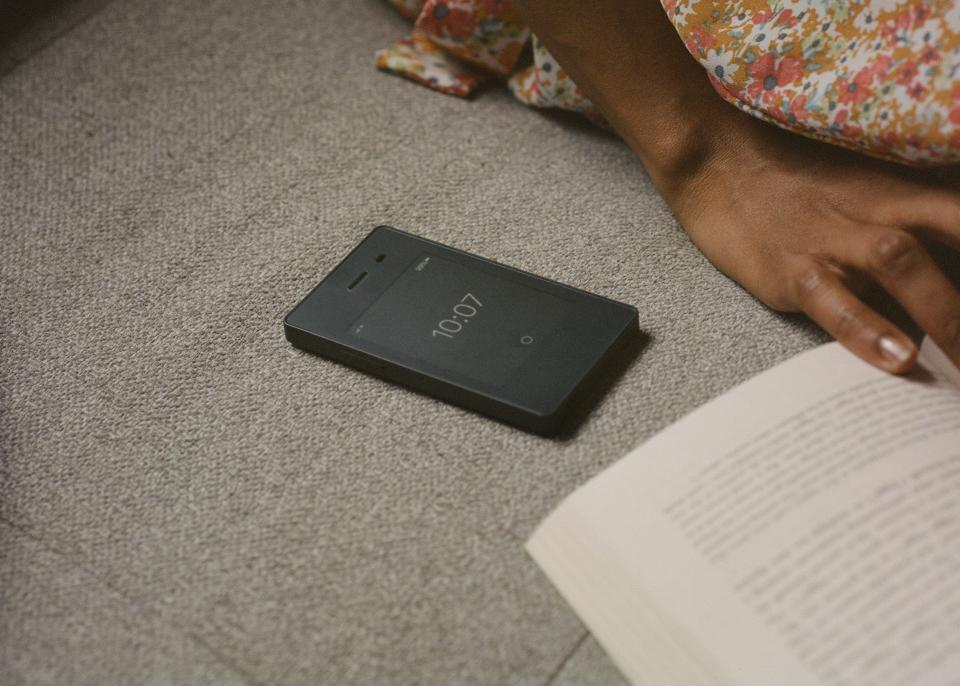Can a Dumb Phone Fix Your Smartphone Addiction?
> $350, Buy now
It is hard to describe how wonderful it is to hold the Light Phone 2 in your hands. The "dumb phone"—with which you can only call, text, or set alarms—is delightfully tiny. It is thinner than my wallet, with a slightly larger footprint than a credit card. Its e-ink screen is extremely pleasant to look at, just like the one on my Kindle, and gives any text you receive the gravity of the book you’re reading during your commute. As soon as I saw it, I knew I needed to have it.

The appeal of a dumb phone is self-explanatory. No 7:35PM email that ruins dinner. No 6:44AM Twitter alert that ruins your workout. No 12:17pm Slack ping that ruins your lunch break. In the parlance of computer scientist Cal Newport, the glut of technologies we employ for their utility are now basically breaking our brains. A phone that can only text and call promises to unhook you from the wheel of push notifications, to help you stop watching life happen and start living it.
This is certainly the viewpoint of the Light Phone’s designers, who have been working to design a phone “to be used as little as possible” since 2015. The company’s website and blog say the phone allows you to enjoy “quality time free of distraction.” The company promises the phone might get some more features, like maps, but it will “never have social media, email, news, or ads.” The first iteration of its phone, which became available to purchase for $150 in January 2017 couldn’t even text. It just made and received calls forwarded to and from your existing smartphone.
The $350 Light Phone 2—announced in early 2018, originally promised to ship in April 2019, now backordered until March 2020—is animated by the same philosophy as its predecessor, but with a functional overhaul. It can now serve as a standalone, unlocked 4G LTE phone, send and receive texts, hold more than nine contacts, and set alarms. It still makes calls, but they no longer route through an app on your smartphone. That means if you want to use it as a true companion to your smartphone, with the same number, you’ll have to work with your phone carrier to get a “duplicate SIM.” (To my knowledge, T-Mobile and Verizon are the only carriers that currently allow you to do this.) And if you do this as an iPhone user, you’ll have to disable iMessage (goodbye, blue bubbles).

These mildly onerous stipulations are annoying, but not nearly as annoying as actually trying to use this phone. With the ringer on, texts arrive with an extremely pleasant chime—evoking the bell you hear in airplanes when the captain mercifully turns the fasten seatbelt sign off. To get to these texts, you must complete a series of precise presses on a screen you quickly find to be extremely laggy. Press the circle at the bottom to open the menu, press the option that says “Phone” to access your contacts, press the relevant conversation (denoted with an asterisk) to see the messages. That might not seem like a vast boundary, but each of these selections seems to take much longer than they might on a contemporary smartphone, or even on the T9 phones of the 90s and early-2000s.
It gets worse when you try to respond to one of these texts, using the phone’s virtual keyboard. Based on my experience typing, even after more than a month of practice, each of the keys are ⅛ the size of my thumbs. Typing as I do on my iPhone resulted in sentences riddled with errors (“I thoughy iy couldnt either”), so responding to a text became a taxing exercise in trying to keep things short without losing nuance and frequently failing. And if anyone sent me a photo or link, neither of which the phone can open, I had to make them describe it—or send it to me in a different way.

In a way, this is the phone’s purpose. It’s supposed to be kind of difficult to use, so that you use it less and re-prioritize. But by disrupting how you are going to communicate, you’re also unwittingly disrupting how everyone else has to communicate with you. This phone is going to obligate them to pick up your slack in ways that you’ll find hard to anticipate. If someone wants to make plans with you, they’ll have to specifically remember that you don’t get Facebook notifications anymore. If your friends want to have a group chat to vent during the workday and bond, you’re going to be a really lackluster participant. If your partner wants to send the contents of the handwritten grocery list you left taped to the fridge, they can’t just snap a picture.
If you’re an Android phone user on a network that allows you to have a duplicate SIM, you can probably manage this. You can use your phone as a companion at the times when you really need to limit distractions and in the abundant situations where being completely plugged in is unnecessary. But you don’t need to buy a $350 device to do this. You can still buy phones of the bygone era of T9 and QWERTY keyboards at most major electronics retailers for well under $100 that offer the same features, but that are designed to be used. Sure they’re less cool, but cool is relative. If Adam Sandler can pull off a successful three-way parlay wearing a leather blazer and round sunglasses (indoors!), you can pull-off a Nokia.
Perhaps an eventual iteration of the Light Phone will strike a better balance between austerity and usability, when more carriers support duplicate SIM cards and Apple plays nicer with third-party manufacturers. But for now, the promise of the Light Phone remains just that—a promise.
The Light Phone 2
$350.00, The Light Phone
Originally Appeared on GQ


